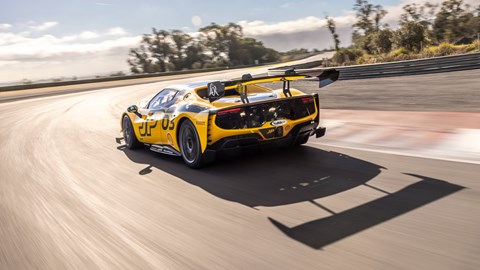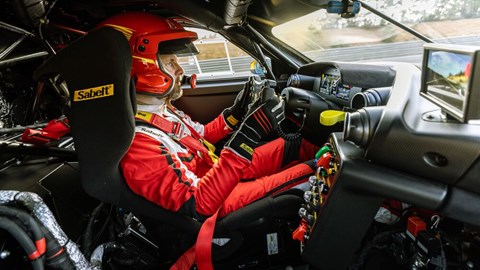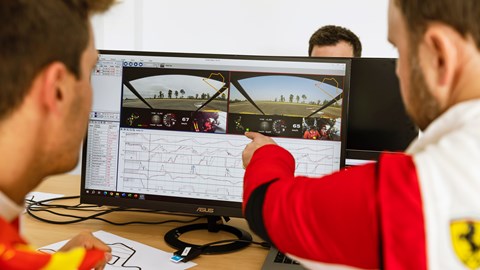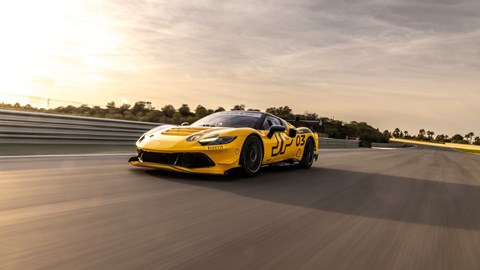With the 296 Challenge racing car, Ferrari’s racing ladder has got a new, £300,000 entry point. But there are ways to earn it back
Monza. 2006. Schumacher is retiring as a Ferrari F1 driver at the Finali Mondiali in front of 45,000 tifosi. Jean Todt patrols the paddocks, his entourage growing like a wake behind a ship as the hordes of mega-wealthy Ferrari customers vie for his attention, each anxious to prove that their particular FXX/312 T/430 Challenge is worthy of a distracted glance from him. Di Montezemolo is here and at the height of his powers, having effectively ‘retired’ Schuey despite all his F1 records. Meanwhile, the grandstands wait with baited breath for … Piers Ward to make his Ferrari debut.
It’s unlikely that the latter is a particular memory-banker for any of those 45,000 adoring fans but to me it remains one of the high watermarks of my career. Never having driven any Ferrari before, let alone raced one, the Temple of Speed is where I got to break my cherry in a 360 Challenge Stradale. Having only ever competed at UK tracks in front of a crowd of three, two of whom were lost, it was a whirlwind introduction to the Prancing Horse and the sheer power of the brand. The addiction of it.

It’s the context you need to understand the 296 Challenge car we’re in today. There are much, much cheaper ways to go racing – the car costs over £300k and a season will probably set you back a cool half mill. But no-one, not even Porsche, can offer amateur drivers that rare opportunity of being so far inside the tent and being so much a part of the Ferrari fraternity. Ferrari owns the entirety of the 296 package, in terms of the car, its build and the series and weekends that it races in, which means that it can offer a unique embrace that no other brand can match. The buzz you get from all that should not be underestimated, a dopamine hit that ultra-high net-worth people can’t get elsewhere.
It’s the first rung on the Ferrari racing ladder and now, thanks to the 499P LMH World Endurance car, it’s a career path that could potentially climax with a Le Mans win: 2024’s enduro winner Nicklas Nielsen was a Challenge champion in 2018.
There are various Challenge series all over the world, from the US to a newly minted one in Australasia, with the culmination at the annual Ferrari-fest, the Finali Mondiali. The series have been running since 1993 with the Ferrari 348 and now, via cars like the 360 Challenge Stradale, through to the 430 and latterly 488 Evo, there’s a new offering, the 296 Challenge.
Through each of those generations, the emphasis has shifted from what was essentially a road car with a cage into the new 296, where it borrows almost as much from the sibling GT3 racer as it does from the GTB road car.

It starts with the body-in-white going down the same Maranello production line as the GTB and into the same paint shop. It also gets the same 2992cc twin turbo V6 as the GTB. But the differences in both the build (after the paint shop, it goes onto a separate build line) and spec are marked: no hybrid thus saving weight and lowering the complexity (overall, the car is 140kg lighter), turbos that now spin 10 per cent faster to 180,000rpm, an engine that goes to 7000rpm, completely new interior including the same seat as the GT3 racer, bespoke carbon ceramic brakes that are made with longer carbon fibre strands that last longer and conduct heat better, a full roll cage that’s installed in two halves and then bolted together. The details on the latter were sweated hard by Ferrari, particularly around the A-pillar to ensure that gentlemen drivers who are, let’s say a generous fit, could get in easily. Having clambered in myself, it’s still mighty tight.
Along with the new brakes, the aero is where things have clearly moved on from the previous Challenge cars. The bald figure is a maximum 850kg of downforce (18 per cent up on the 488 Evo) but it’s the downforce ‘map’ which Ferrari used that’s the most impressive part, almost like an aerodynamic mood board. Think gentle curves and pillowy landings rather than cliff-edge drama.
Balance was key. It needed to have plenty of downforce to give race-car performance but if it was too peaky, the amateur drivers that will form the core of the car’s target market wouldn’t cope.

To that end, the S-Duct on the bonnet plays a crucial role. Ground effect is a significant source of the car’s downforce but, as we all know from F1, it’s subject to huge variances depending on the car’s ride height and pitch. By using the S-Duct to connect the under- and upper-body and maximise the efficiency of the central diffusor, it keeps the aero more stable.
Strapped in, with an instructor waiting nervously in the passenger seat, everything feels very real. Steering wheel pulled right out and up, almost uncomfortably close. Belts tight enough to corset the chest. Pit lane speed limiter on. Ignition and battery rocker switches engaged. Starter button pressed.
The 296 explodes with no cold-start, all-mouth/no-trousers whoomph. It fires as it means to go on: loud, focused, raw, with zero fripperies or light bars dancing across the nose.
Pull out of the pits and into the first corner. Woah, the brake pedal is light. Delicate to the point of feeling like an EV run to the shops. The steering as well. So nimble but with minimal weight. Even the shift paddles drop in the next cog with a gentleness that belies every cliché you ever imagine of a racing car. This is not a thing that intimidates in the weight of all its controls.

Even the throttle response is gentle. With the large twin turbos, the pace climbs gently rather than snapping you into wharp speed. It’s easy to modulate.
Of course it’s fast. But those initial laps reveal it to be an approachable thing, a car that you can build up to and that impresses from the off before revealing more and more as your confidence grows.
Ferrari offers customers full telemetry, crucially with a coach to interpret it all and offer tips, which for me can be summed up in just two words: ‘Brake later’. I do find one moment where I’m quicker than the Delta target lap and proudly declare this to my bemused instructor, but the overall story is a consistently depressing one of being both way too early on the brakes and not using enough pressure. Literally less than half the brake pressure into some corners.
Heading back out for another run – four laps followed by a data crunch is an effective way to learn – I do eventually pluck up the courage to hit the stoppers where they want me to at the end of Monteblanco’s start-finish straight.

This feels better, bleeding the brakes into the apex and using them to rotate the car rather than furiously and repeatably stabbing the throttle. It’s a complete mental switch for me and where I need to unlearn a lot of my habits from racing historic cars, in which I (probably incorrectly) get on the accelerator early to use it to get the nose rotating. In the Ferrari, you have to trail brake into the heart of the corner, then on the power. I’m consistently too eager to jump on the right pedal but at slower speeds, the aero isn’t working so all it does is wash the nose wide.
There are two traction control settings – the 296 Challenge’s equivalent of the GTB’s Manettino – and I can feel them trying to tug it straight via the e-Diff and engine mapping. There’s never any danger of going off with armfuls of understeer, but it isn’t quick.
When the car hooks up – or rather when I can actually drive it as I should – it transforms. You don’t feel the aero hunkering you down like you do, say, in a Porsche 963, but it is a mighty stable machine. There’s one flat right hander that requires a gear change mid-corner, a moment that would yield quite some trepidation in an historic car. In the 296, it never even enters my mind. The gearchange is quick and smooth, the car remains flat and committed.

By bleeding out of the brakes correctly as you approach the apex, the 296 feels wonderfully linear and arcs beautifully from a left into a right, the nose tucked correctly and the rear following dutifully. There are no awkward momentum shifts because everything is so harmonious. The power comes easily and you can sense the increased speed. And there are, at last, some vaguely positive comments from the passenger seat.
Then we get given a hot lap ride with Thomas Neubeuer in the driving seat, an ex-Challenge racer who’s now signed up to Ferrari’s works program. And all of a sudden the 296 reveals its ultimate potential, in a brutal, chest-smashing experience that shows just how physical you can be with the car. ‘Brake later’ is not a phrase with which Thomas is familiar. I’ve been lucky enough to experience plenty of hot laps with pros, but I don’t remember one that was this violent. Kerbs are shown no mercy and he’s incredibly physical with the steering, using a combination of it and the sheer speed of the car to bully the physics into submission. He is definitely not paying for any of the consumables on this car.
When I raced that 360 Challenge at Monza, it all felt a bit vacuous – there were quick drivers competing but it lacked the gravitas of a Porsche Cup round. It was lovely and very special – what other 26-year old bloke ever gets to experience that sort of weekend as work – but it also felt slightly fake. Wealth with little sense of reward.

But things have changed since then and Ferrari has got wise to the potential of tapping into two revenue streams: money and talent. By offering a route beyond the Challenge series into the likes of the GT World Challenge Europe Sprint Cup (what was the Blancpain series) and fully-fledged LMGT3, there is now a clear path. By creating a machine in the 296 that is so close to being an actual racing car that it allows Maranello to properly assess driving ability, Ferrari can mine a rich seam both of gentlemen drivers and hot young talent.
The car is incredibly impressive but as ever with Ferrari, it’s the eco system around it that is the difference. I’ll wait for the call…
- Price: £316,314
- Powertrain: 2992cc turbo twin-turbo V6, seven-speed dual clutch, rear-wheel drive
- Performance: 690bhp @ 7500rpm, 546lb ft @ 6000rpm
- Weight: 1330kg (dry)
- Length/width/height: 4851/1958/1231mm (*including rear wing)
- Efficiency: n/a
On sale Now